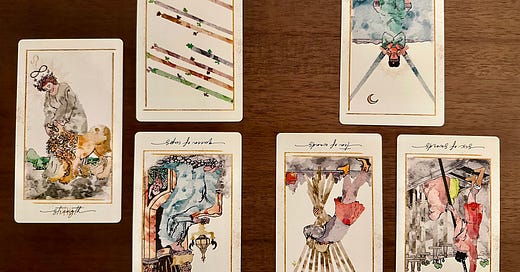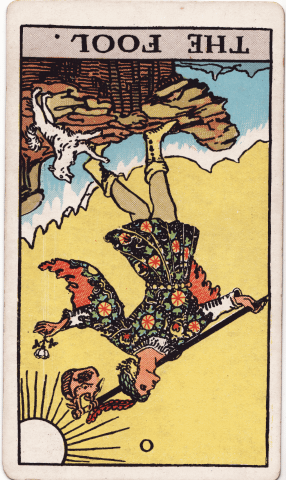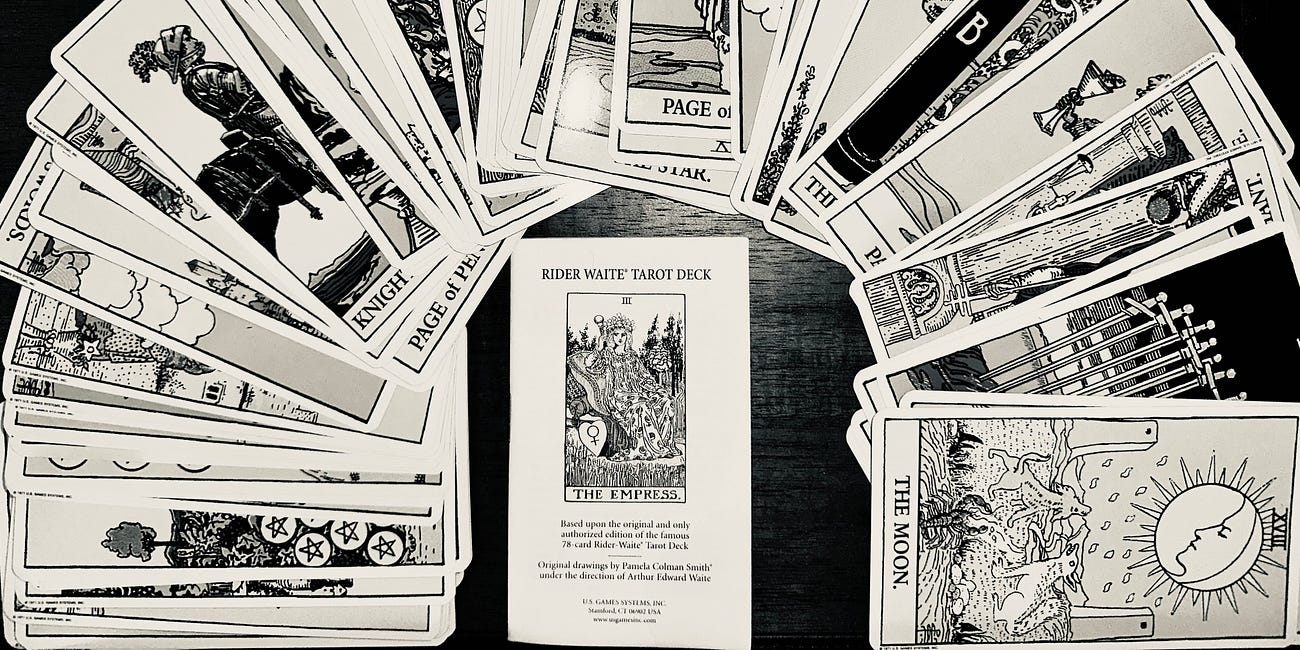Using Tarot for Writing Stories, Part 5
A New Challenge: The Reversals Spread
The contentious issue of reading versus not reading tarot card reversals is one of confusion and frustration for many readers. You will hear very specific opinions (for or against) on whether reversals are natural in the act of reading a spread. This post is a challenge to this issue to help the blocked creative. We are going to purposely turn these cards around to its reversed state to get a deeper and more complex story. It will probably turn darker, meaning more intense emotions or actions. Doesn’t that make a good story, though? Obstacles, transformation, heightened emotions . . . that’s the best kind of story to read.
I have read the online discussions of readers who are passionately against reading reversals - its unnatural, its disrupts the flow of energy, its too hard, avoid it like the plague! I’ve seen plenty the other side of the argument, as well - it adds more layers, more distinction, digs deeper into an issue. I have always read reversals, mostly due to the decks I bought early on including the meanings of the inverted cards. I never questioned or thought to not read them this way. So, I learned. I choose to read it with a combination of intuitive insight and weaving into the story of the cards in the spread. The traditional reversal meaning do come to play as well, but it is secondary. Even today, reversals may stump me. Sometimes it just doesn’t make sense and I will flip it if it feels more correct.
In my research to find an easy way to teach reversals, I found a blog post, Creative Soul Tarot, which cited a book I really should own, but somehow do not - Holistic Tarot: An Integrative Approach to Using Tarot for Personal Growth by Benebell Wen. I’ve put this on my wishlist, for sure. The blog author, Julie Embleton, cites this book’s very simple way to approach to interpreting reversals:
W: Weakened energy of the card meaning due to being overpowered by other forces.
I: Inverted meaning of the card, i.e., the opposite of what the card would mean upright.
N: Negative influence on Seeker (most notably in court cards; think N for nobility).
D: Delay before the outcome will materialise. Not all factors have fully matured yet.
Let’s Practice
Sit and think about this for a moment: You are staring at a reversal in a spread and feel stumped. It makes no sense and you are about to open a book to tell you the meaning. I would encourage you to take a moment to go through the WIND method before consulting someone else’s meanings. Let’s go through a simple example using the first card in the Major Arcana, The Fool.
The Fool card, in the most general sense, indicates the start of a new journey and adventure, packed with his companion and ready to go. The cliff our Fool is walking off gives the impression that the future is indeed unknown - will they fall if they take that great leap of faith? With any new journey comes inherent risk, and this is where our reversal comes into play. Let’s take this card through the WIND method.
W: Weakened energy of the card meaning due to being overpowered by other forces. The new journey/adventure is ahead, but if surrounding cards indicate a hesitation, this energy can bring anxiety. All the “what if’s” can dampen any excitement which would typically be present.
I: Inverted meaning of the card. Our Fool is headed on a new adventure, but perhaps he has not thought it through completely when considering the risks. The element of recklessness and true foolishness is a strong energy here. Best to stop and take a moment to reconsider options.
N: Negative influence on Seeker. Sometimes we don’t want what life gives us. New things in life are not always positive or desired. If we must face it, we will need to keep our eyes open and heads up - do the best we possibly can given the circumstances.
D: Delay before the outcome will materialise. Not all factors have fully matured yet. The “not yet, but soon” rationale. Perhaps this new journey is still not here, but surrounding cards indicate that it could happen once the seeker is ready.
Take context from the surrounding cards to see what fits the cards - it will dictate the story of our reversed card.
Is there a court card looking at The Fool? What would that person have to say?
Are there any swords pointing at The Fool?
Are there people in any of the surrounding cards? What are they doing?
Is there a dominant suit (pentacles, wands, cups, swords) or are they Major Arcana around The Fool? What does that have to say?
If there are Major Arcana cards, what are the overall archetypes/themes?
What does the numerology mean, if you pulled a card with numbers 1 though 10?
Write out some open-ended notes to see what’s happening with our Fool. It opens up new possibility and depth for our spread.
Let’s Apply This to Creative Stories - The Spread
I am using a tarot deck from Writual, the creator of the tarot-based planner I use year round. It’s fantastic. This deck came from my best friend’s estate after her death, and I remember her telling me that this deck was everything she wanted a Rider-Waite deck to be with its artistic style. She loved watercolor, and in her honor I am using this deck. I will unveil more decks I received over time as they are all amazing.
I didn’t have a solid plan, initially, when I was thinking about what kind of spread would work best for this example. The way I work is purely intuitive. Sometimes I have a picture in my mind of what I should create, such as the placement of the cards in the spread, but not what the cards’ positions represent. Or its the opposite, where I know what the card positions will generally address and need to create the physical placement of the cards in the spread.
For this one, I played it fast and loose. I knew only two things for sure - the Major Arcana needs to be separated out and shuffled. The remaining cards, the Minor Arcana, should be shuffled together. After some experimenting, this is what poured out of my brain.
I am approaching this spread with creative fiction in mind. The scenario is creating a character who needs to embrace an archetype in their live/circumstance, however they are experiencing some serious shadow elements which block their path to resolution.
1 - Desired Archetype: Strength
Pull a card from the Major Arcana stack, and lay it out in the normal position (non-reversed) even if you deal it out reversed.
Strength is a straightforward card which needs little explanation. Our character needs to pull up their strength to make a choice between two tough paths. To embody the strength, the hard choice may not feel good, but the best under the circumstances.
The Conflict (Card 2 v. Card 3)
2 - Eight of Wands (Reversed)
I chose to use the Inverted meaning of the card here. Unpleasant life circumstances are moving quickly. Note the flying wands in the card, and that they are flying into the group of cards to the right, which represents the tough choice. However, what is flying quickly is rife with issues and disruptions.
3 - Queen of Swords (Reversed)
I chose to use the Negative influence on Seeker to determine what this means for our character. This character is essentially putting their head in the sand when if comes to making good choices in this unpleasant situation. They are not recognizing their emotions in a healthy manner, and are instead expressing thier emotional volatility in extreme ways, such as using escapism (ex. drugs or alcohol) to mask self-pity, or denying their emotions to become numb and cold. Either way, it has a negative impact on our character. Also note that her face is directly looking at the cards on the right, the hard choice.
The Hard Choice (Card 5 v. Card 6)
4 - Two of Swords (Reversed)
Pull this card specifically out of the Minor Arcana stack - this represents the difficult choice. Notice that the swords are pointing respectively towards each choice below. See how the imagery dictates what needs to be done?
5 - Ten of Wands (Reversed)
I chose to use the weakened energy of the card meaning due to being overpowered by other forces. We know by this point in our spread that our character is at a crossroads, and these difficult circumstances influence the Ten of Wands. Remember that quick little note I made about numerolgy above? We had the Eight of Wands as the quick-moving unpleasant situation coming down hard on our character. Now, we are at the Ten of Wands - its here in its full glory, representing completion. The questions for this position and card combination are - (1) does our character crumble under the weight of life and give up?, (2) will doing that make anything better?, or (3) are they unable to recognize the full weight of it?
6 - Six of Swords (Reversed)
I chose to use the delay before the outcome will materialise meaning for our character. The sixes generally indicate movement across the Minor Arcana. Seeing the Six of Swords in the reversed position here as an opposition to the heavy burden of the Ten of Wands (Reversed) is pretty clear - that boat isn’t moving easily, in fact it is likely hugging the banks and trudging along in water too shallow. This is straightup fear for our character, however, they cannot escape the conflict - it must be confronted despite feeling stuck in the mud.
I put this spread together in a very purposeful way, choosing cards that show this method at its best. We have multiple things going on in the spread to help the reader use their judgement based on the images pointing to one another with swords and wands, numerology, and one example each of the four WIND elements of reading reversals.
This story could be placed in a creative story - in any genre. It is adaptable - if any of those elements need a backstory or clarification, simply pull a few cards on that element to see what the story has to say.
I hope this was interesting and helpful - if you use this spread, please let me know how it went in the comments.
Hey! Catch up on this series!
Using Tarot for Writing Stories, Part 1
I’ve decided to write about how I use tarot with creating stories. While I have personally been using the cards for way too long, I am going to start with the basics - just enough to get someone started assuming they have not used them before. I pulled together a few things, and
Using Tarot for Writing Stories, Part 2
Welcome to Part 2! If you have not read part 1, please do so. This is a big one, and it is dense with information.
Using Tarot for Writing Stories, Part 3
If you have not read part 1 and 2 yet, I highly recommend you do so before proceeding:
Using Tarot for Writing Stories, Part 4
Part 1 of this series presented a basic overview of tarot, for the non-tarot person in mind:











I think that you will really enjoy Holistic Tarot. It is one of my absolute favorite books on Tarot.
Loved the exploration here Erica. Lots of food for thought. Also well shared and written.
Yes, reversals are quite the controversy. I started my tarot journey using them. Then when my tarot readings became more spread based, I used the spreads to draw out the challenges and depth. Initially I was still using them, but it was complicated when reversals came into a shadow position of the spread. Was it a double negative, canceling each other out? Was it augmenting the reversal? Over time I stopped using reversals traditionally. Also because I began to look at both the upright and the reversal aspect of the card when doing a reading. Letting the other cards call it out. What cards are around it, the position, the number, etc. bringing forth whether the focus needed to be reversal or upright. So I guess after all that I do use reversals, just not in the traditional sense. And YES!!! Readings do tell a story. Always fascinating what they reveal.